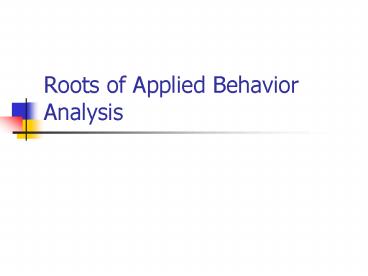Roots of Applied Behavior Analysis - PowerPoint PPT Presentation
1 / 20
Title:
Roots of Applied Behavior Analysis
Description:
Roots of Applied Behavior Analysis Explanations of Human Behavior Why do people behave the way they do? Can we predict behavior? Why do people behave in socially ... – PowerPoint PPT presentation
Number of Views:278
Avg rating:3.0/5.0
Title: Roots of Applied Behavior Analysis
1
Roots of Applied Behavior Analysis
2
Explanations of Human Behavior
- Why do people behave the way they do?
- Can we predict behavior?
- Why do people behave in socially inappropriate
ways?
3
Useful theories
- Inclusive it must explain a substantial amount
of behavior - Verifiable can we test it out?
- Predictive utility can we use the theory to
predict what someone may do under similar
conditions? - Parsimonious is it the simplest explanation?
4
Biophysical Explanations
- Genetic or hereditary factors
- We are often predisposed to behave a certain way
- temperament including activity level,
adaptability, threshold of responsiveness,
distractibility, persistence, etc. - Genetics may Increase the probability of certain
behavioral characteristics
5
Biochemical explanations
- Excesses or deficiencies of certain chemicals
determine certain behaviors or disorders i.e.,
autism - No proof the abnormalities exist but may not be
the cause - Past belief that biochemical or physiological
influences result in brain damage but this is
unsubstantiated
6
Developmental Explanations
- Psychoanalytic theory progression through
certain stages as an explanation - Piaget cognitive and moral stages of development
7
Cognitive Explanations
- Discovery learning
- Motivation is intrinsic
- Teachers do not impart knowledge, they rearrange
the environment to facilitate learning - Constructivism students must construct their
own knowledge - Concept development is the goal
8
Behavioral Explanations
- Behavior is learned
- Functional relationship between two environmental
events behavior and consequence (POSITIVE
REINFORCEMENT) - NEGATIVE REINFORCEMENT a behavior increases
when an unpleasant environmental condition is
removed or reduced in intensity
9
Behaviorism (contd)
- EXTINCTION When a previously reinforced
behavior is no longer reinforced, the behavior
decreases - ANTECEDENT CONTROL discriminative stimulus an
antecedent that occurs right before the behavior
(it occasions the behavior) - Stimulus control the relationship between the
behavior and the antecedent
10
Antecedent Stimulus
- Antecedent stimulus serves as a signal or cue
for the behavior - Setting events- influence behavior by temporarily
changing the value or effectiveness of a
reinforcer - Simple kind of setting event satiation or
deprivation - Kazdin social, physiological, and environmental
11
Setting events
- Bailey, Wolery, Sugai instructional
dimensions, physical dimensions, social
dimensions, and environmental changes - Issues of students ethnic or cultural heritage
Personalized Contextual Instruction (see box pg
14-15)
12
Other learning principles
- Modeling demonstration of the behavior
- Shaping reinforcement of successive
approximations to a desired behavior
13
Behavior
- Must be able to see or hear or feel or smell the
behavior - Observable
- Quantifiable
- Less concerned with explaining a behavior and
more concerned with describing it - Which environmental factors increase, decrease,
or maintain the behavior?
14
Behaviorists
- Pay attention to heredity, psychological
problems, or developmental stages - Priority is on present environmental conditions
that maintain behavior and the relationships
between the conditions and the behavior - Manipulate the variables
15
Historical development of Behaviorism
- Pavlov Respondent conditioning with dogs
- food UCS tone CS
- Salivation - UR salivation CR
- Pairing stimuli so that an unconditioned stimulus
elicits a response respondent, Pavlovian, or
classical conditioning
16
Associationism
- Edward Thorndike work with cats
- Law of Exercise a response made in a particular
situation becomes associated with that situation - Law of Effect any act which in a given
situation produces satisfaction becomes
associated with that situation, so that when the
situation recurs that act is more likely than
before to recur also
17
Behaviorism
- Originated by Watson (1914-1925) mind,
instinct, thought, emotion not useful in in
understanding behavior - Albert and the white rat conditioned a startle
response in a baby by pairing with loud noise
with a white rat - Fear is a conditioned response
18
Operant conditioning
- B.F. Skinner (1904-1988) distinguished
operant from respondent conditioning - Respondent conditioning reflexive
- Operant conditioning voluntary behavior
- Concerned with consequences of behavior and the
functional relationships between behaviors and
consequences - Moved from the laboratory into applied settings
Behavior modification
19
1960s
- Much research Journal of Applied Behavior
Analysis - Baer for research to qualify as Applied Behavior
Analysis, it must - change socially important behavior
- deal with observable and quantifiable behavior
- be objectively defined
- demonstrate clear evidence of a functional
relationship between the behavior and the
intervention
20
Applied Behavior Analysis
- More rigorously defined than behavior
modification - Must have effective analysis of behavior change
through documentation































